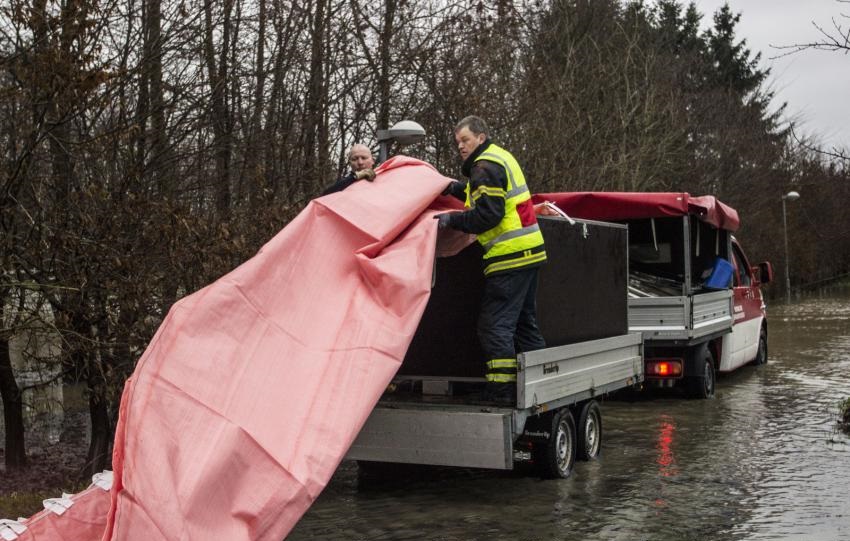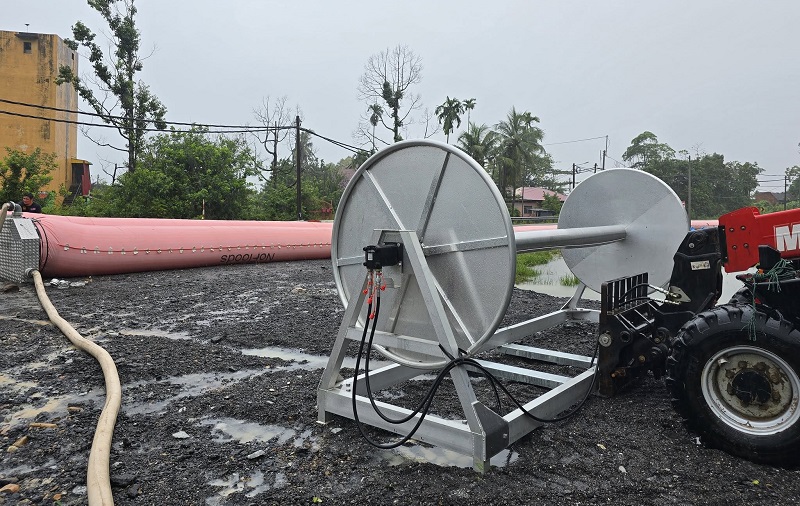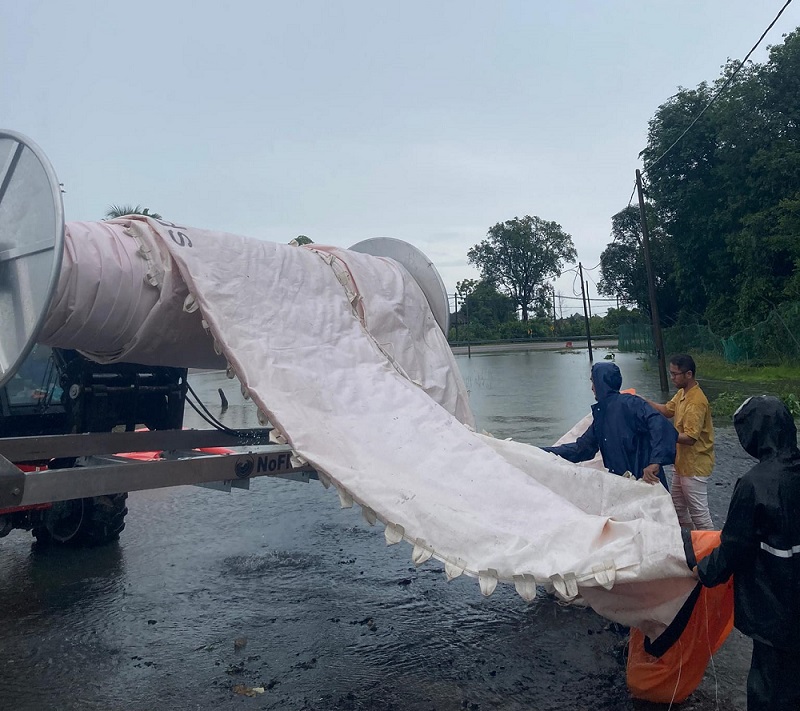NoFloods: The Ultimate Road Flood Protection Barrier
Road flood protection barriers have become essential as flooding intensifies worldwide, driven by climate change and rapid urbanization.
These barriers play a critical role in safeguarding roads and infrastructure – lifelines that keep communities connected.
Flooded and damaged roads don’t just mean inconvenience, they disrupt access to emergency services, food supplies and safe shelter, putting lives and livelihoods at risk.
In countries like Malaysia, seasonal floods during the Northeast Monsoon are notorious for isolating communities, damaging critical road networks and compounding economic challenges.
This is where the NoFloods road flood protection barrier comes in.
More than just a temporary fix, it’s an innovative practical solution that redefines flood preparedness.
With its flexible design and easy deployment, this barrier offers a smarter, more efficient way to safeguard roads and protect communities from the devastating impacts of flooding.
Let’s kick things off by looking at how it works to protect road networks against Mother Nature’s fury.
How Do the NoFloods Road Flood Barriers Work?

The NoFloods Barrier is a cutting-edge road flood protection solution designed for rapid deployment and exceptional performance in mitigating flood impacts.
Combining innovative engineering with smart technology, these barriers offer a reliable and efficient defence for flood-prone roads.
Mechanics of Operation
At the core of the barrier’s functionality is its unique use of water (the threat), as a counterweight, enabling it to form a sturdy and impenetrable barrier against floodwaters.
Here’s how it works:
- Positioning of the barrier: Deploy the NoFloods Barrier effortlessly by positioning it directly along roads or perimeters straight from its storage box, trailer or truck.
- Filling the barrier: Next, the barrier is filled with water, stabilising it and ensuring it remains in place, even against strong currents.
- Creating a shield: The filled barrier forms a solid flexible wall that effectively blocks floodwaters, preventing them from inundating roadways and nearby infrastructure.
- Adaptability: The barrier conforms to uneven terrain, making it suitable for diverse environments, including rural roads, urban streets and highways.
IoT Integration
One of the standout features of the NoFloods Barrier is its integration with smart sensors and Internet of Things (IoT) technology, enhancing its performance and reliability.
- Real-Time Monitoring: IoT-enabled sensors monitor flood conditions and water levels, providing live data to decision-makers.
- Proactive Deployment: This data allows authorities to predict flooding risks and deploy the barriers precisely where and when they are needed.
- Remote Management: Smart applications linked to the barriers offer remote oversight, reducing the need for on-site monitoring and enabling more efficient resource allocation during flood emergencies.
Deployment Strategies
The NoFloods Barrier is specifically engineered for ease of deployment, making it an ideal choice for rapid flood response.
Key deployment features include:
- Lightweight and portable design: Made from durable yet lightweight materials, the barriers are easy to transport and handle, even in challenging conditions.
- Rapid setup: A team of just four people can deploy up to 1,000 meters of barrier in less than four hours, making it one of the fastest road flood defence systems available.
- Scalable Solution: The barriers can be configured to protect specific road sections or extended to cover long stretches, depending on the flood risk and site requirements.
- Reusable and Sustainable: After use, the barriers can be emptied, cleaned and stored for future deployment, offering long-term cost savings and reducing environmental impact.
Additional Advantages
- Minimal infrastructure disruption: The barriers require no heavy machinery or permanent installation, ensuring that roads and surrounding areas remain intact and accessible.
- Flexibility across sites: Whether for urban settings with paved roads or rural areas with uneven terrain, the NoFloods Barrier adapts seamlessly to different conditions.
- Cost-Effectiveness: By reducing damage to infrastructure and cutting down recovery times, the barriers are a financially sound investment for flood-prone road networks.
The NoFloods Barrier exemplifies the future of road flood protection, combining rapid deployment, intelligent technology and environmental sustainability to provide a comprehensive defence against flooding.
Installation Considerations of NoFloods Barriers

Proper installation of NoFloods Barriers is critical to ensuring their effectiveness in road flood protection.
By carefully assessing the site and following best practices for setup, these barriers can offer maximum reliability and durability during flood events.
Site Assessment
Before deploying the barriers, a thorough site evaluation is essential to determine the best placement and ensure optimal performance.
Key factors to consider include:
- Terrain Analysis:
- Assess the road’s topography and surrounding land to identify areas most prone to flooding.
- Check for uneven surfaces, slopes or obstacles that may impact the barrier’s stability.
- Flood Risk Assessment:
- Understand the flood patterns and water levels in the area, especially in regions affected by seasonal flooding or heavy rainfall.
- Identify the highest-risk zones along the road that require immediate protection.
- Environmental Conditions:
- Consider soil type, vegetation and nearby structures, as these factors can influence water flow and barrier placement.
- Account for potential debris carried by floodwaters that could obstruct the barrier or reduce its effectiveness.
- Access and Logistics:
- Ensure easy access for transporting and deploying the barriers.
- Evaluate storage options for quick access during emergencies.
Installation Techniques
The NoFloods Barrier is designed for efficient setup, but proper installation is essential to maximize its flood protection capabilities.
Below is a step-by-step guide to installing these barriers:
- Preparation:
- Clear the designated area of debris, sharp objects or anything that could compromise the barrier’s integrity.
- Positioning:
- Deploy the barrier along the road.
- Ensure that the barrier is aligned correctly, following the natural contours of the terrain.
- Filling:
- Fill the barrier with water to create the necessary counterweight for stability.
- Monitor the water level during filling to ensure consistent pressure across the entire barrier.
- Securing:
- Check for gaps or weak points, especially at the joints between barrier sections.
- Use provided connectors or reinforcements to secure the barrier segments together.
- Testing:
- Perform a quick test by simulating light water flow to confirm the barrier is properly sealed and stable.
- Monitoring:
- Once deployed, continuously monitor the barrier, especially during prolonged flood events, to ensure it remains intact and effective.
Additional Tips for Success
- Training: Ensure that the deployment team is trained in the installation process to avoid delays or errors during emergencies.
- Maintenance checks: Periodically inspect the barriers for damage or wear, especially after each use.
- Integration with flood management plans: Incorporate the NoFloods Barrier into broader flood response strategies for a coordinated and efficient defence system.
Proper installation and site preparation make the NoFloods Barrier one of the most reliable road flood protection solutions available, offering peace of mind and effective flood mitigation when it’s needed most.
Benefits of Using the NoFloods Road Flood Defence System
Economic Benefits
- Prevents costly damage to roads, bridges and drainage systems.
- Keeps transportation running, avoiding business disruptions.
- Reduces flood-related insurance claims and premiums.
Environmental Benefits
- Made from reusable and recyclable materials, reducing waste.
- Protects ecosystems by preventing soil erosion and water contamination.
- Leaves no lasting environmental footprint, ideal for sensitive areas.
Social Benefits
- Ensures safe, accessible routes for emergency services and evacuations.
- Reduces stress by offering reliable flood protection.
- Helps communities recover faster and maintain stability.
Additional Advantages
- Adaptable for urban and rural road networks.
- Scalable for various road protection needs.
- Quick and resource-efficient deployment during emergencies.
Case Study: NoFloods, The Ultimate Road Flood Protection Barrier
The Malaysian government in partnership with Infra Water, our Malaysian distributor, is conducting a pilot project for flood mitigation technology along Federal Road FT189 in Terengganu.
Launched in October 2024 and running through March 2025, this project showcases the innovative potential of NoFloods as an effective temporary road flood defence solution.
Project Details
The NoFloods Pro barrier was installed along a 300-meter road section frequently affected by flooding.
The area was selected as part of a “sandbox program” by Malaysia’s Ministry of Works to test the barrier’s effectiveness during the monsoon season.
The system leverages Internet of Things (IoT) technology for real-time flood monitoring and response.
IoT sensors collect data on water levels and send instant alerts, allowing the system to be activated efficiently when water levels rise.
Performance Highlights
- Proven Flood Control: The NoFloods Pro barrier has successfully halted floodwaters up to 0.9 meters high and in its triple configuration, it can handle levels as high as 1.2 meters. This has helped minimize road closures and damage.
- Temporary Yet Effective: Described as functioning like a “Bailey bridge,” the barrier offers a non-permanent, flexible solution for emergency flood response while safeguarding roads and users.
- Comprehensive Testing: The technology is undergoing a six-month proof-of-concept evaluation, aligning with the region’s monsoon period, to determine its long-term viability.
Benefits to Infrastructure and Safety
The primary goal of the pilot project is to protect public infrastructure and ensure road connectivity during floods.
Specifically, the barrier is preventing:
- Road closures caused by floodwaters spilling onto the road network.
- Premature deterioration of road surfaces due to prolonged water exposure.
- Compromised safety for road users during adverse weather conditions.
Moreover, the solution has proven to be a cost-effective alternative for the government, as the testing phase incurs no direct costs to public agencies.
Pilot Project Receives Media Attention
The NoFloods Barrier received significant media attention in Malaysia during the commencement of the pilot project.
Major outlets covered the deployment, showcasing how the barrier is transforming road flood protection.
Astro AWANI, a leading news network, highlighted the barrier’s rapid deployment and its positive impact during the pilot project.
You can watch the coverage in the video below:
BERNAMA TV, another prominent Malaysian news channel, also featured the pilot project.
You can watch the coverage below:
Here are some photos of the NoFloods barrier in action:







Additionally, here are some photos from Alexander Nanta’s Facebook post:
Potential for Wider Implementation
The Minister of Works, Alexander Nanta Linggi, praised the NoFloods technology for its practicality and immediate impact.
If the trial succeeds, this system could be adopted for broader use across other flood-prone regions in Malaysia.
Through initiatives like these, Malaysia is taking significant steps to modernize its flood mitigation strategies.
NoFloods, The Future of Road Flood Protection
As climate change intensifies and weather patterns become increasingly unpredictable, the demand for advanced and efficient road flood protection solutions has never been more critical.
The NoFloods Barrier stands at the forefront of this evolution, offering a transformative approach to mitigating the devastating effects of flooding on roads and infrastructure.
Traditional methods such as sandbags and permanent levees are no longer sufficient to address the growing complexity of flood risks especially on road networks.
Sandbags for instance are labor-intensive, time-consuming to deploy and environmentally unsustainable due to the disposal challenges they pose.
In contrast, the NoFloods Barrier represents a paradigm shift, combining cutting-edge design with unparalleled efficiency and sustainability.
As we look to the future, it’s clear that road flood protection must evolve beyond reactive measures.
Proactive, efficient and environmentally sound solutions like the NoFloods Barrier are essential for building resilient communities.
Its ability to rapidly safeguard critical infrastructure combined with its commitment to sustainability ensures that the NoFloods Barrier is not just a solution for today but a cornerstone of future road flood resilience strategies.
It is not merely a product, it is a revolution in road flood prevention!
Don’t wait for the next flood to strike – take a proactive step now to ensure the safety and resilience of your roads and community.
Contact us today to learn how the NoFloods road flood protection barrier can transform your flood defence strategy.
Together we can build a future where floods no longer bring chaos but are met with confidence and preparedness.
Frequently Asked Questions (FAQs)
1. What are road flood barriers and how do they work?
Road flood barriers are protective structures designed to block or redirect floodwaters, preventing road inundation and safeguarding infrastructure, vehicles and pedestrians.
They use innovative designs like self-anchoring systems to stabilize against water pressure.
The primary purposes of road flood barriers include:
Flood containment: Prevent water from breaching roadways, ensuring safe and dry access during floods.
Flood diversion: Redirect floodwaters to safer areas such as drainage systems or flood basins, minimizing damage during heavy rain or storm surges.
2. Why are road flood protection barriers essential?
- Economic Importance: They protect vital trade and transportation routes, reducing losses from damaged infrastructure and disrupted commerce.
- Public Safety: Barriers keep roads operational during floods, ensuring access for evacuations, relief efforts, and medical services.
- Climate Adaptability: As floods worsen due to climate change, barriers offer scalable solutions for managing unpredictable weather events.
Road flood barriers are key to immediate protection and long-term resilience in sustainable infrastructure planning.
4. What are the types of road flood barriers?
- Temporary Road Flood Barriers
These barriers, like the NoFloods Barrier, are quick to deploy and ideal for seasonal or unpredictable floods.
Made from durable lightweight materials, they are reusable, portable and friendlier to the environment.
Filled with water during setup, they create a strong impermeable wall to protect roads.
- Permanent Road Flood Barriers
Constructed from concrete, steel, or masonry, these barriers provide long-term protection in high-risk flood zones.
While durable and effective, they are costly, rigid and less adaptable to changing conditions compared to temporary options.
5. How effective are temporary flood barriers for roads?
Temporary barriers are highly effective for short-term needs, offering quick deployment and substantial protection when installed correctly.
6. What materials are used to make road flood protection barriers?
Common materials include galvanized steel, aluminum, reinforced concrete and water-resistant fabrics for inflatable options.
7. How can I install a road flood prevention barrier?
Installation involves site preparation, barrier assembly, anchoring and sealing.
Temporary systems are often user-friendly and require minimal tools.
8. What is the best type of flood barrier for road protection?
The best type depends on your needs: temporary barriers for emergencies and permanent barriers for long-term solutions.
In many instances, a combination of temporary and permanent protection offers the ideal solution.
9. Can road flood barriers be used in residential areas?
Yes, roadside flood barriers can effectively protect homes and local streets from flooding.
10. How do I choose the right flood barrier for my road?
Consider factors like flood risk, terrain, budget and the frequency of flooding in the area.
11. What are the benefits of using road flood prevention barriers?
They reduce damage, protect ecosystems and ensure public safety during flooding events.
12. How do flood barriers for roads prevent flooding during heavy rain?
By creating a physical barrier or redirecting water flow, they keep floodwaters away from roads and adjacent infrastructure.
13. Are there any maintenance requirements for road flood protection barriers?
If you’d like to learn more about our flood protection solutions, feel free to get in touch with us here.
Yes, regular inspections and cleaning are essential to maintain functionality and durability.